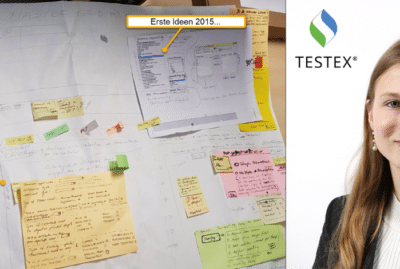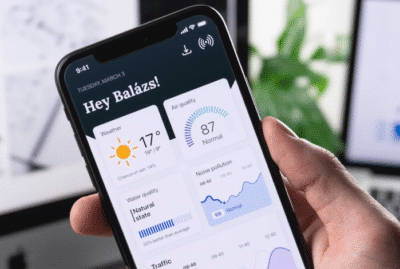One of the central topics in IT is the exchange of data between different systems via so-called interfaces. The implementation and maintenance requires not only technical expertise, but also an understanding of the underlying business logic of the systems. In the field of software development, the term API (Application Programming Interface) plays a central role. The terms «application interface» and «programming interface» emphasise the important function of the API in facilitating communication between different software applications and enabling them to seamlessly exchange data and commands.
API definition: What you need to know about programming interfaces

What are interfaces and why are they important?
Interfaces, also known as APIs (Application Programming Interfaces), serve as intermediaries between different software applications, systems or services. They enable them to communicate with each other, exchange data and utilise functions. The importance of interfaces lies in the fact that they enable companies to integrate their systems, automate processes and utilise data efficiently. This allows them to reduce costs, increase productivity and improve the customer experience. Specifically, an API enables communication and data exchange between different software programmes, which is crucial for the planning, development and testing of software by facilitating access to databases, components and the creation of graphical user interfaces.
What is an API? - Definition
An API is an interface and a part of a programme that enables different software applications to communicate with each other and exchange information. It defines the rules and protocols for this interaction and enables developers to utilise functions and data of an application without knowing its internal structure. In addition, APIs provide a programmed interface at the source code level for integration with other applications, enabling access to databases and components as well as the creation of graphical user interface elements.
Interfaces – simply explained
Imagine an interface as a bridge between two islands. On one side you have your data or services, and on the other side are the applications or devices that want to use that data. The interface allows these two sides to communicate with each other and exchange information, much like a bridge allows people to get from one island to another.
In simple terms, an interface is like a translator that ensures that different applications or systems can talk to each other, even if they use different languages or formats. It makes communication smooth and efficient without users having to realise any of the complex technical details behind it.
How do APIs work?
APIs act as intermediaries between different applications by receiving and processing requests and returning corresponding responses. The REST architecture is a favoured standard for application development as it provides a unique architecture for APIs that enables communication over the Internet. Developers use the functions and methods provided to access the desired data or services and integrate them into their own applications. API management is also a critical aspect that includes activities such as publishing the API, enabling access based on owner-defined permissions or policies, security and administration of the API. Tools such as API catalogues or directories are used for API management.
Examples of software interfaces
Software interfaces can be found in a variety of applications and services that we use every day. Here are some common examples of software interfaces:
- Web APIs: Web APIs allow websites and web applications to communicate with each other and exchange data. A well-known example is the Google Maps API, which allows developers to integrate maps and location data into their applications.
- Library APIs: Library APIs provide functions and services within a programming language or framework. Examples of this are the standard libraries of programming languages such as Python or JavaScript, which provide developers with a variety of useful functions.
- Operating system APIs: Operating system APIs allow interaction with a device’s operating system to control various functions such as file access, network communication and device management. Examples include the Windows API for Windows operating systems and the POSIX API for Unix-based operating systems.
- Database APIs: Database APIs enable access to databases and the execution of queries and operations. One example is the JDBC API for Java applications, which enables developers to interact with relational databases such as MySQL or PostgreSQL.
- SOAP and RESTful APIs: SOAP (Simple Object Access Protocol) and RESTful (Representational State Transfer) APIs are two different approaches to developing web services and APIs. Both enable communication between different applications, whereby RESTful APIs are based on the REST principles and are often used in modern web applications.
Challenges in interface integration
Complexity of systems: Many Swiss SMEs have a variety of systems and applications that do not always communicate seamlessly with each other. Integrating this heterogeneous landscape can be a challenge.
Resource constraints: Smaller companies often have limited resources, be it financial or human. Implementing and maintaining interfaces can therefore be an additional burden.
Security concerns: In Switzerland, the protection of data and compliance with data protection regulations is taken very seriously. SMEs need to ensure that interfaces are secure and sensitive information is adequately protected.
Lack of expertise: Not all SMEs have in-house IT experts with sufficient expertise to develop and maintain interfaces. This can lead to delays and errors.
Why APIs are important for companies
APIs play a central role in the digital transformation of companies and are an essential part of their future-oriented strategies. Here are some reasons why APIs are crucial for organisations:
Integration of systems and services
Organisations often have a variety of systems and services that do not always communicate seamlessly with each other. APIs make it possible to integrate these heterogeneous landscapes and ensure smooth interaction between them. This allows companies to optimise their processes, use data more efficiently and improve collaboration between different departments and business partners. APIs are crucial for enabling communication between different software applications, which forms the basis for the integration and functionality of modern IT systems.
Accelerating the development of innovative solutions
APIs offer developers the opportunity to access existing functions and services instead of having to develop everything from scratch. This speeds up the development of applications and enables companies to react quickly to changing market conditions and offer innovative solutions for their customers.
Opening up new business opportunities
By providing APIs, companies can make their services and data accessible to external developers. This creates new business opportunities in the form of partnerships, integrations and the development of ecosystems around their products and services. Companies can tap into additional revenue streams and maximise their business potential.
Improving the customer experience
APIs allow companies to extend their services to different platforms and channels to provide a seamless and consistent experience for their customers. By integrating APIs into mobile apps, websites, social media and other channels, companies can extend their reach and improve interaction with their customers. Using APIs to improve the functionality and performance of websites, for example by integrating flight prices or property listings, is another example of the many uses of APIs.
Increasing efficiency and reducing costs
By automating processes and standardising interfaces, APIs can increase efficiency and reduce costs. They enable companies to automate recurring tasks, reduce manual work and utilise resources more efficiently.
How do you choose the right interface for your company?
Choosing the right interface depends on several factors, including the type of applications to be integrated, existing infrastructure, scalability requirements and security concerns. It is important to conduct a thorough analysis and weigh the pros and cons of each option before making a decision. If necessary, you can also draw on the expertise of an experienced IT partner like soxes AG to ensure you get the best possible solution for your organisation.
Best practices for the use of interfaces
- API documentation: Make sure your interfaces are well documented so that developers can easily understand and use them.
- Security: Implement appropriate security measures to protect your interfaces from unauthorised access and data misuse.
- Monitoring and maintenance: Monitor your interfaces regularly to recognise and rectify performance problems or failures at an early stage.
- Versioning: Implement a clear versioning strategy to ensure that changes to your interfaces do not affect existing integrations.
Where did soxes use interfaces?
In complex software solutions such as the instaSOLUTION communication and management solution, many components communicate with each other. Interfaces are used for hardware components, between databases, clients and much more. In order to successfully cope with the high data throughput, these had to be designed to be suitably robust. To this end, soxes used all its expertise in the field of interface design.
REFCO, an established Swiss company in the field of refrigeration and air conditioning technology, worked with soxes to develop the innovative “REFMESH” app, which is available on iOS and Android. This app enables technicians on site to connect to REFCO devices to read real-time data, generate customer reports and transfer saved measurements. REFMESH offers a variety of features to manage data and create reports that can be sent directly to customers. The app was developed with React Native, which enables cross-platform use. It communicates via an API with the Python-based back-end, which establishes a database connection. By introducing this digital solution, REFCO is taking an important step towards digitalisation and offering its customers an efficient tool to support their day-to-day work.
Reichmuth & Co. commissioned soxes to develop a digital consulting tool to optimise their processes in the financial sector. The tool, closely coordinated with the client, reduces the workload and the flood of documents. A specific requirements specification was created through a comprehensive UX workshop. The application uses a REST API in the backend, implemented with ASP.NET and C#, and an Angular-based user interface to retrieve data from the SQL server database. The client-server architecture improves scalability and creates a central control point for resources and sensitive data. Through continuous adjustments in the agile process, the tool is customised even more to the needs of Reichmuth & Co. and its customers.
Contact
Do you have any questions? Would you like to find out more about our services?
We look forward to your enquiry.
Contact us







































































